
Amidst a recent surge in international gold prices, Singapore has witnessed a remarkable increase in the sales of gold bars and coins. Local gold traders report robust physical gold transactions between January and April this year. Notably, Singaporeans purchased 2.5 tonnes of gold bullion from January to March, marking a substantial 35% increase compared to the same period last year and the largest year-on-year jump since 2010.
Despite the spot price of gold surpassing $3,000 per ounce in March and further climbing to $3,500 in less than two months, the appetite of buyers remains strong, with continued robust purchasing activity. Experts attribute this surge in gold buying to heightened risk aversion stemming from increasing global economic uncertainty. Geopolitical tensions and inflation concerns are driving investors towards gold, a traditional safe-haven asset, as a means of protecting their wealth.
Gregor Gregersen, founder of ‘The Reserve,’ a high-capacity gold and silver storage facility in Changi, noted a trend among some ultra-high net worth clients shifting from ‘paper gold’ assets to physical gold. He explained, "Some clients want to hold gold physically. They have significant amounts of paper gold assets and are increasingly concerned about potential future scenarios." This suggests a move beyond speculative buying for profit, indicating a long-term asset shift to hedge against potential economic turmoil.
Shaokai Fan, Head of Asia Pacific (ex-China) and Central Banks at the World Gold Council, emphasized gold's resilience during uncertain times. He also highlighted growing concerns about the future of traditional safe-haven assets like the US dollar and US Treasuries. This implies a re-evaluation of what constitutes a safe haven, with physical assets like gold gaining renewed importance.
However, not all gold-related assets have experienced increased demand. The demand for gold jewelry saw a 20% year-on-year decrease in the first quarter, largely attributed to the record-high gold prices. Brian Lan, a gold trader, pointed out that gold jewelry tends to be more expensive due to labor costs in the crafting process and is subject to Goods and Services Tax (GST), unlike investment-grade gold bars. These factors appear to have dampened the desire for jewelry purchases.
Looking ahead, analysts anticipate that sustained gold buying by central banks will continue to support demand and potentially drive prices to new record highs. Central banks worldwide are increasingly diversifying their foreign exchange reserves and seeking a hedge against economic and political uncertainties by increasing their gold holdings. This trend is expected to provide a strong floor for gold prices. Furthermore, the preference for safe-haven assets among individual investors is likely to persist, suggesting that the fervor in the global gold market, including Singapore, will likely continue for the foreseeable future.
The gold investment boom in Singapore reflects more than just a change in individual investment behavior. It underscores the increasing prominence of gold as a safe-haven asset in an environment of escalating global economic instability. The confluence of geopolitical risks, inflationary pressures, and increased volatility in major currencies is reinforcing gold's role in stabilizing investment portfolios amidst turbulent financial markets.
Moreover, Singapore's position as a financial hub, coupled with its high levels of personal wealth, likely amplifies the gold investment trend. Financially savvy investors with substantial assets are increasingly turning to physical gold as a hedge against economic uncertainties. This highlights a re-evaluation of the stable value of physical assets like gold in an era marked by the volatility of digital assets and the fragility of traditional financial markets.
The current trends in Singapore's gold market offer valuable insights into the future direction of the global gold market. Should economic uncertainties persist and the demand for safe-haven assets remain strong, gold prices could see further appreciation. Investors should closely monitor these market dynamics and consider the role of gold in their investment strategies, while also remaining mindful of the potential for volatility inherent in any investment.
[Copyright (c) Global Economic Times. All Rights Reserved.]






























